An Experimental and Numerical Study on the Use of Chirped FBG Sensors for Monitoring Fatigue Damage in Hybrid Composite Patch Repairs
Abstract
1. Introduction
2. Experimental Study
2.1. Experimental Procedure
2.2. Visual Damage Observations
2.3. Reflected Spectra Produced under Quasi-Static Loading
2.4. Spectra Generated during Damage Growth
3. Prediction of the Reflected Spectra for Undamaged and Damaged Patch Repairs
3.1. FE Model and Predicted Reflected Spectra of the Repaired Coupon without Damage
3.2. Predicted Reflected Spectra of the Repaired Coupon Due to Fatigue Damage
4. Concluding Remarks
Author Contributions
Funding
Institutional Review Board Statement
Informed Consent Statement
Data Availability Statement
Conflicts of Interest
References
- Schubbe, J.J.; Mall, S. Investigation of a cracked thick aluminum panel repaired with a bonded composite patch. Eng. Fract. Mech. 1999, 63, 305–323. [Google Scholar] [CrossRef]
- Schubbe, J.J.; Mall, S. Modeling of cracked thick metallic structure with bonded composite patch repair using three-layer technique. Compos. Struct. 1999, 45, 185–193. [Google Scholar] [CrossRef]
- Soutis, C.; Duan, D.M.; Goutas, P. Compressive behaviour of CFRP laminates repaired with adhesively bonded external patches. Compos. Struct. 1999, 45, 289–301. [Google Scholar] [CrossRef]
- Soutis, C.; Hu, F.Z. Design and performance of bonded patch repairs of composite structures. Proc. Inst. Mech. Eng. Part G J. Aerosp. Eng. 1997, 211, 263–271. [Google Scholar] [CrossRef]
- Sun, C.T.; Klug, J.; Arendt, C. Analysis of cracked aluminum plates repaired with bonded composite patches. AIAA J. 1996, 34, 369–374. [Google Scholar] [CrossRef]
- Baker, A.; Gunnion, A.J.; Wang, J.; Chang, P. Advances in the proof test for certification of bonded repairs—Increasing the Technology Readiness Level. Int. J. Adhes. Adhes. 2016, 64, 128–141. [Google Scholar] [CrossRef]
- Yashiro, S.; Wada, J.; Sakaida, Y. A monitoring technique for disbond area in carbon fiber–reinforced polymer bonded joints using embedded fiber Bragg grating sensors: Development and experimental validation. Struct. Health Monit. 2017, 16, 185–201. [Google Scholar] [CrossRef]
- Kakei, A.; Epaarachchi, J.A.; Islam, M.; Leng, J. Evaluation of delamination crack tip in woven fibre glass reinforced polymer composite using FBG sensor spectra and thermo-elastic response. Measurement 2018, 122, 178–185. [Google Scholar] [CrossRef]
- Rajabzadeh, A.; Heusdens, R.; Hendriks, R.; Groves, R. Characterisation of transverse matrix cracks in composite materials using fibre Bragg grating sensors. J. Lightwave Technol. 2019, 37, 4720–4727. [Google Scholar] [CrossRef]
- Chen, J.; Wang, J.; Li, X.; Sun, L.; Li, S.; Ding, A. Monitoring of temperature and cure-induced strain gradient in laminated composite plate with FBG sensors. Compos. Struct. 2020, 242, 112168. [Google Scholar] [CrossRef]
- Palaniappan, J.; Wang, H.; Ogin, S.L.; Thorne, A.; Reed, G.T.; Tjin, S.C. Use of conventional and chirped optical fibre Bragg gratings to detect matrix cracking damage in composite materials. J. Phys. 2005, 15, 55–60. [Google Scholar] [CrossRef]
- Palaniappan, J.; Ogin, S.L.; Thorne, A.M.; Reed, G.T.; Crocombe, A.D.; Capell, T.F.; Tjin, S.C.; Mohanty, L. Disbond growth detection in composite-composite single-lap joints using chirped FBG sensors. Compos. Sci. Technol. 2008, 68, 2410–2417. [Google Scholar] [CrossRef]
- Okabe, Y.; Tsuji, R.; Takeda, N. Application of chirped fiber Bragg grating sensors for identification of crack locations in composites. Compos. Part A Appl. Sci. Manuf. 2004, 35, 59–65. [Google Scholar] [CrossRef]
- Palaniappan, J.; Wang, H.; Ogin, S.L.; Thorne, A.M.; Reed, G.T.; Crocombe, A.D.; Rech, Y.; Tjin, S.C. Changes in the reflected spectra of embedded chirped fibre Bragg gratings used to monitor disbonding in bonded composite joints. Compos. Sci. Technol. 2007, 67, 2847–2853. [Google Scholar] [CrossRef]
- Capell, T.F.; Palaniappan, J.; Ogin, S.L.; Thorne, A.M.; Reed, G.T.; Crocombe, A.D.; Tjin, S.C.; Wan, Y.; Guo, Y. Detection of defects in as manufactured GFRP-GFRP and CFRP-CFRP composite bonded joints using chirped fibre Bragg grating sensors. Plast. Rubber Compos. 2009, 38, 138–145. [Google Scholar] [CrossRef]
- Rito, R.L.; Crocombe, A.D.; Ogin, S.L. Health monitoring of composite patch repairs using CFBG sensors: Experimental study and numerical modelling. Compos. Part A Appl. Sci. Manuf. 2017, 100, 255–268. [Google Scholar] [CrossRef]
- Marsden, W.M. Damage Accumulation in a Woven Fabric Composite. Ph.D. Thesis, University of Surrey, Guildford, UK, 1996. [Google Scholar]
- Xu, M.G.; Archambault, J.L.; Reekie, L.; Dakin, J.P. Discrimination between strain and temperature effects using dual-wavelength fibre grating sensors. Electron. Lett. 1994, 30, 1085–1087. [Google Scholar] [CrossRef]
- Jones, F.R.; Mulheron, M.; Bailey, J.E. Generation of thermal strains in GRP. J. Mater. Sci. 1983, 18, 1533–1539. [Google Scholar] [CrossRef]
- Palaniappan, J.; Wang, H.; Ogin, S.L.; Thorne, A.; Reed, G.T.; Tjin, S.C.; McCartney, L.N. Prediction of the reflected spectra from chirped Bragg gratings embedded within cracked crossply laminates. Meas. Sci. Technol. 2006, 17, 1609–1614. [Google Scholar] [CrossRef]
- ASM. “Al 2014-T6 Material Data Sheet”. Available online: http://asm.matweb.com/search/SpecificMaterial.asp?bassnum=MA2014T6 (accessed on 25 October 2013).
- AASHTO LRFD. Bridge Design Guide Specifications for Gfrp-Reinforced Concrete Bridge Decks and Traffic Raillings; American Association of State Highway and Transportation Officials: Washington, DC, USA, 2009; p. 46. [Google Scholar]
- Sabelkin, V.; Mall, S.; Hansen, M.A.; Vandawaker, R.M.; Derriso, M. Investigation into cracked aluminium plate repaired with bonded composite patch. Compos. Struct. 2007, 79, 55–66. [Google Scholar] [CrossRef]
- Jülich, F.; Roths, J. Determination of the effective refractive index of various single mode fibres for fibre Bragg grating sensor applications. In Proceedings of the SENSOR+TEST Conferences, Nürnberg, Germany, 26–28 May 2009; pp. 119–124. [Google Scholar]
- Ouellette, F. Dispersion cancellation using linearly chirped Bragg grating filters in optical waveguides. Opt. Lett. 1987, 12, 847–849. [Google Scholar] [CrossRef] [PubMed]
- Optigrating, version 4.2; Optiwave Corporation: Ottawa, ON, Canada, 2008.
- Rito, R.L. Monitoring Damage Development in Composite Repairs Using Chirped Fibre Bragg Grating Sensors. Ph.D. Thesis, University of Surrey, Guildford, UK, 2015. [Google Scholar]
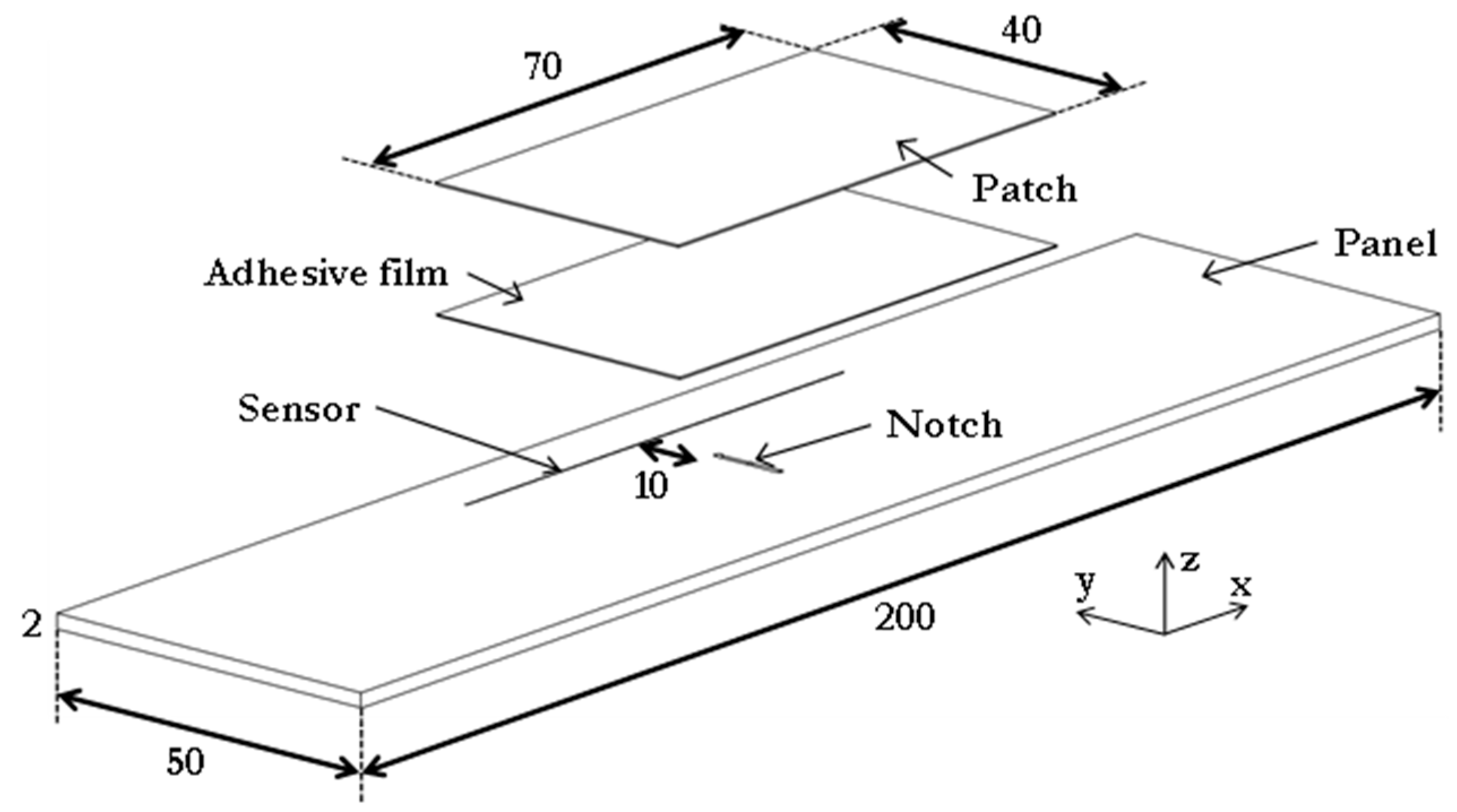

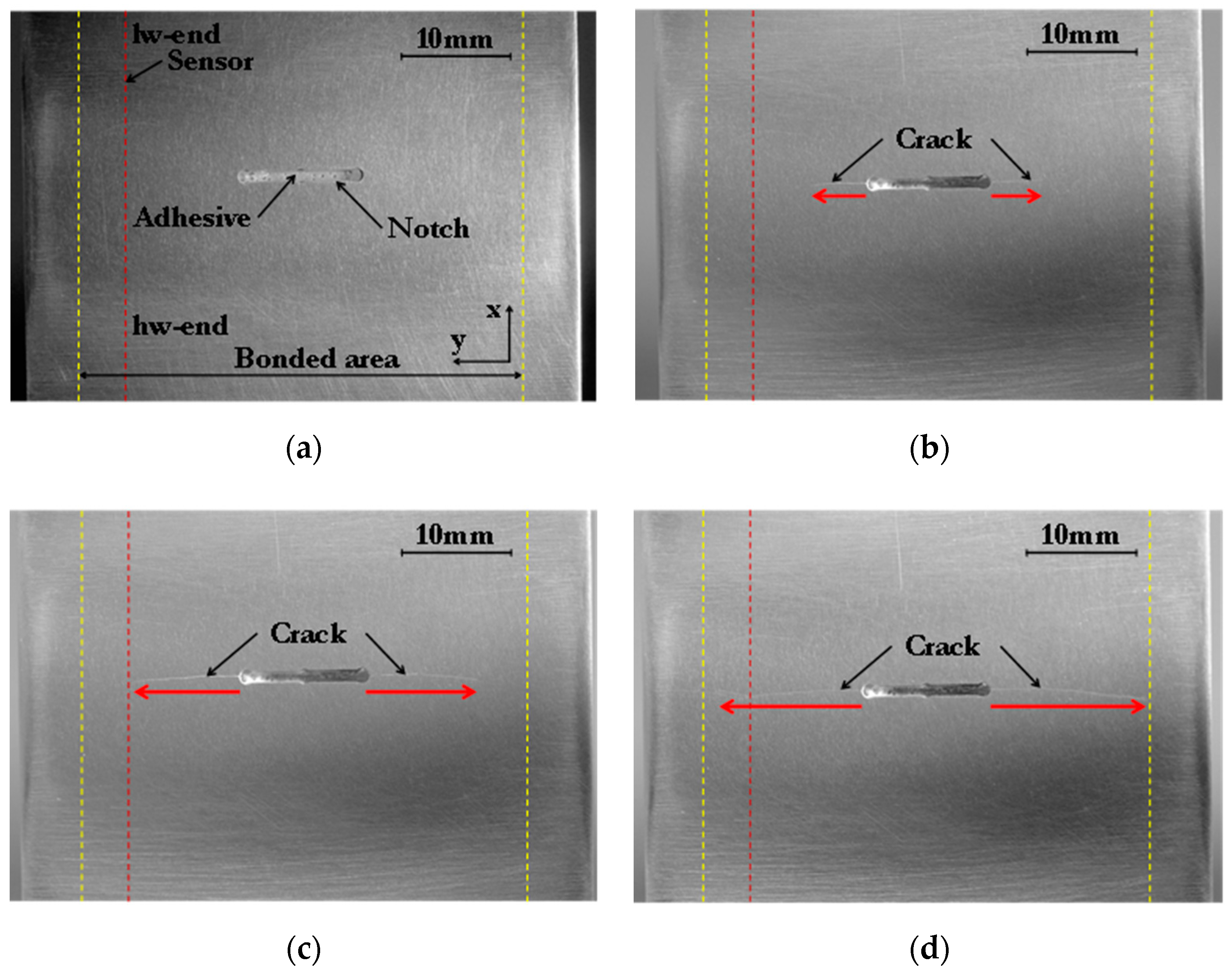

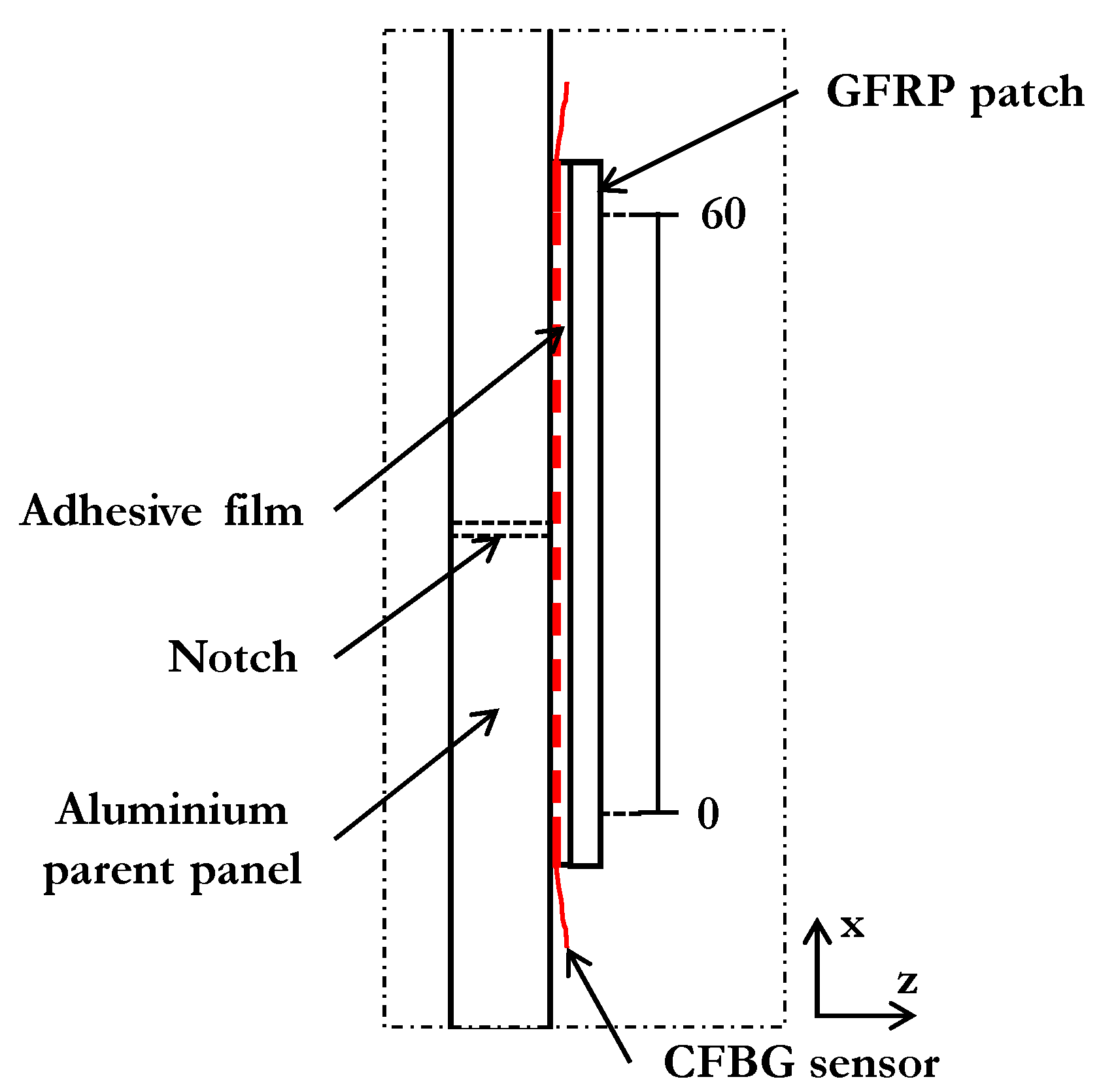
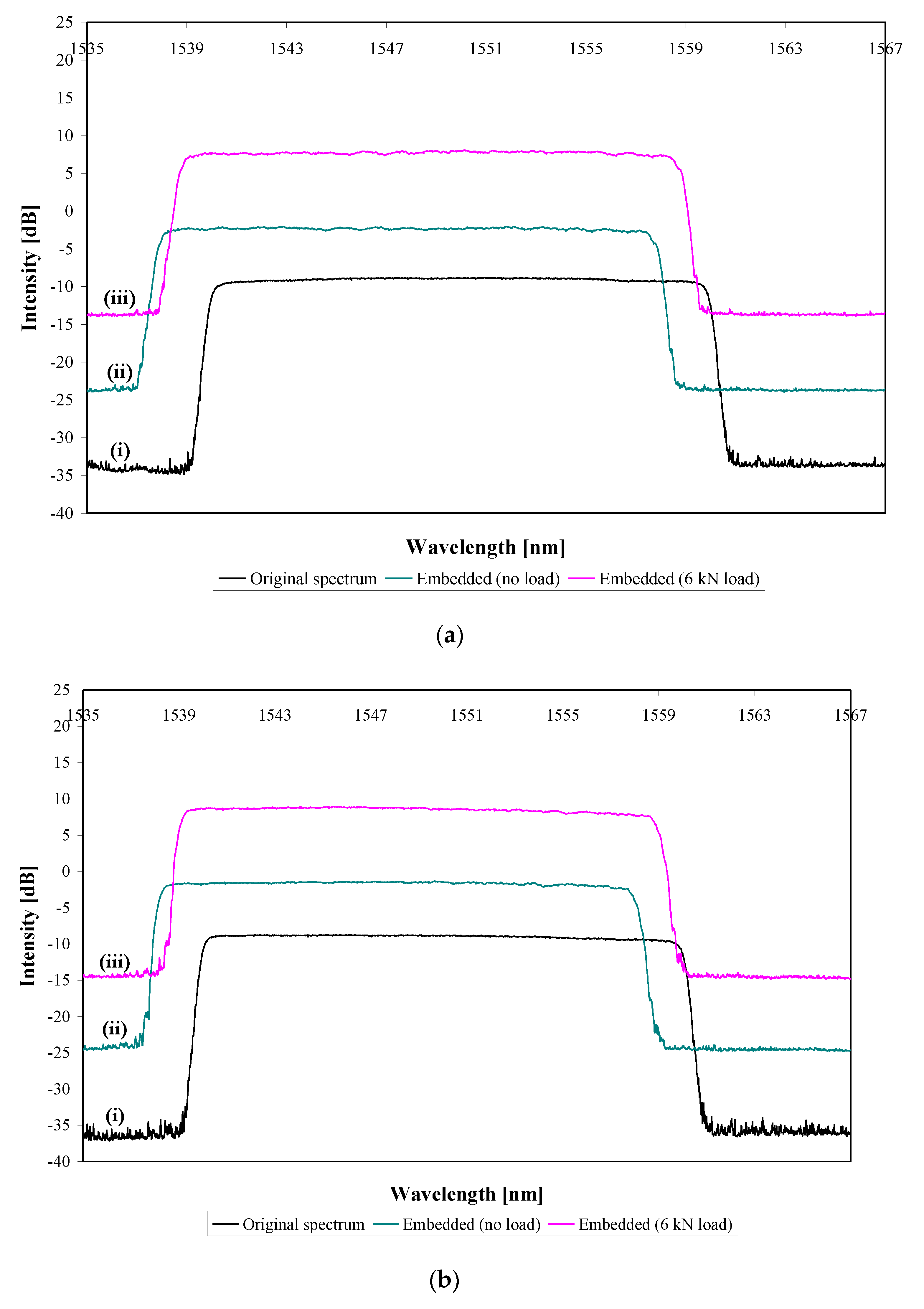



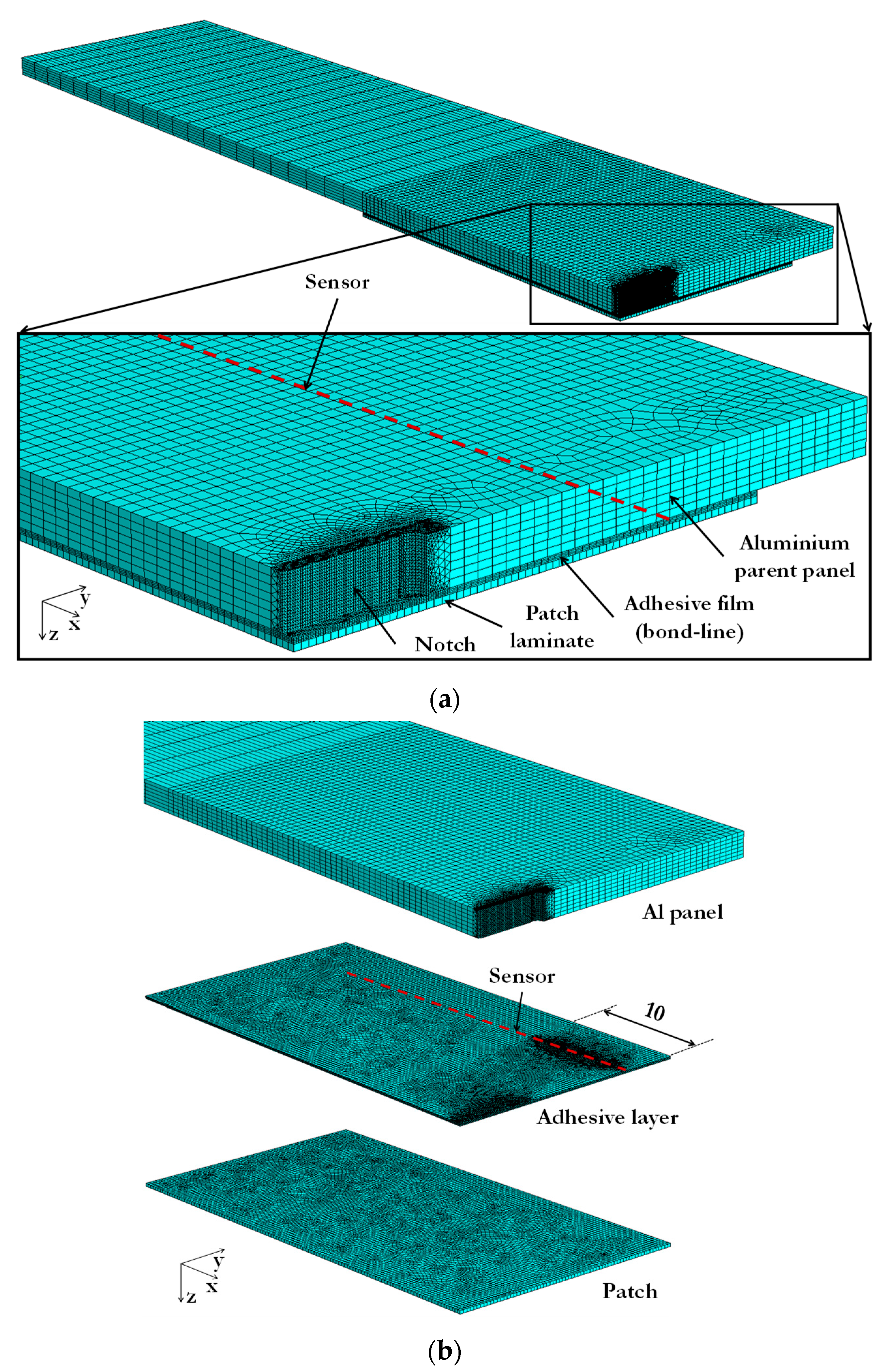
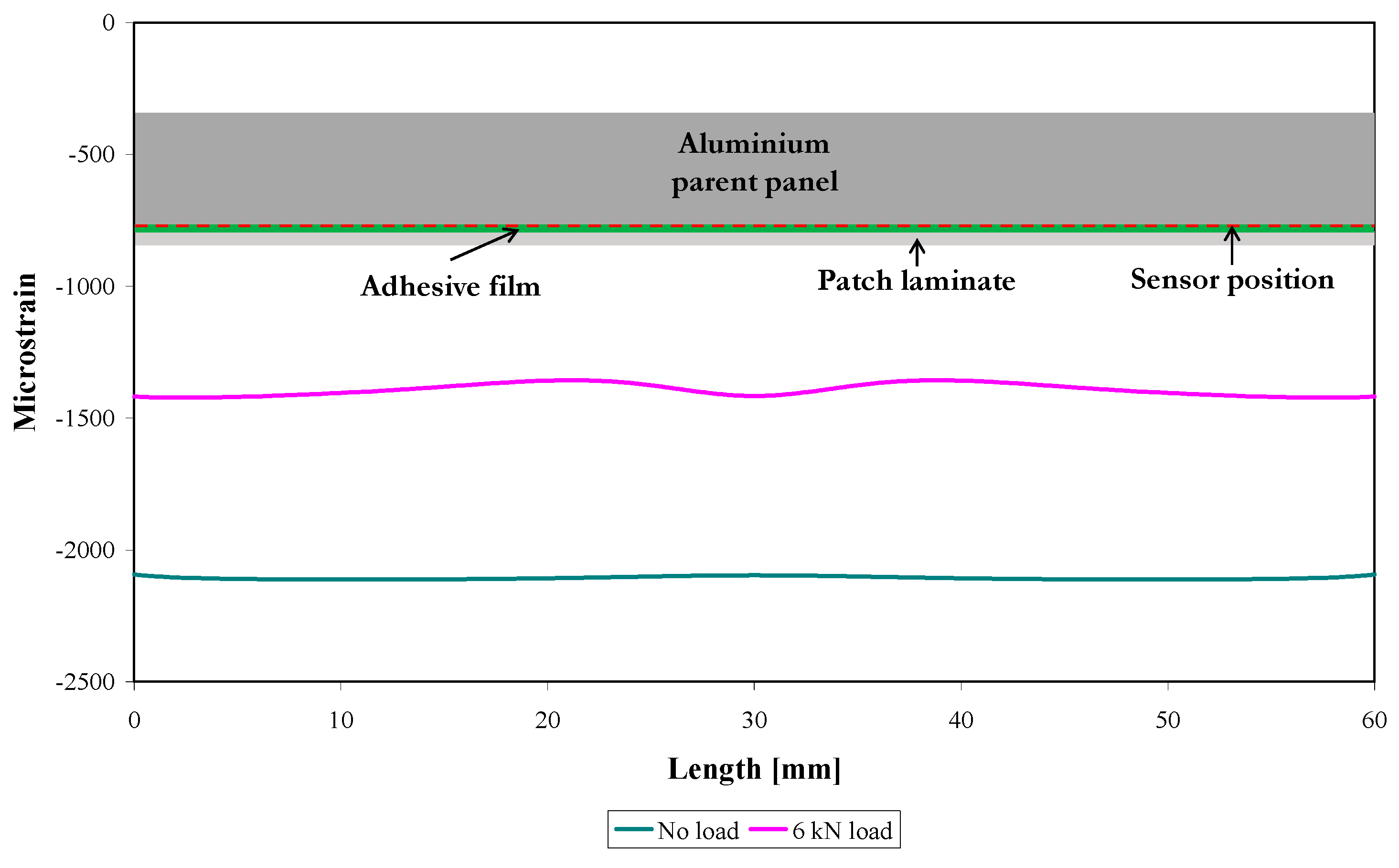
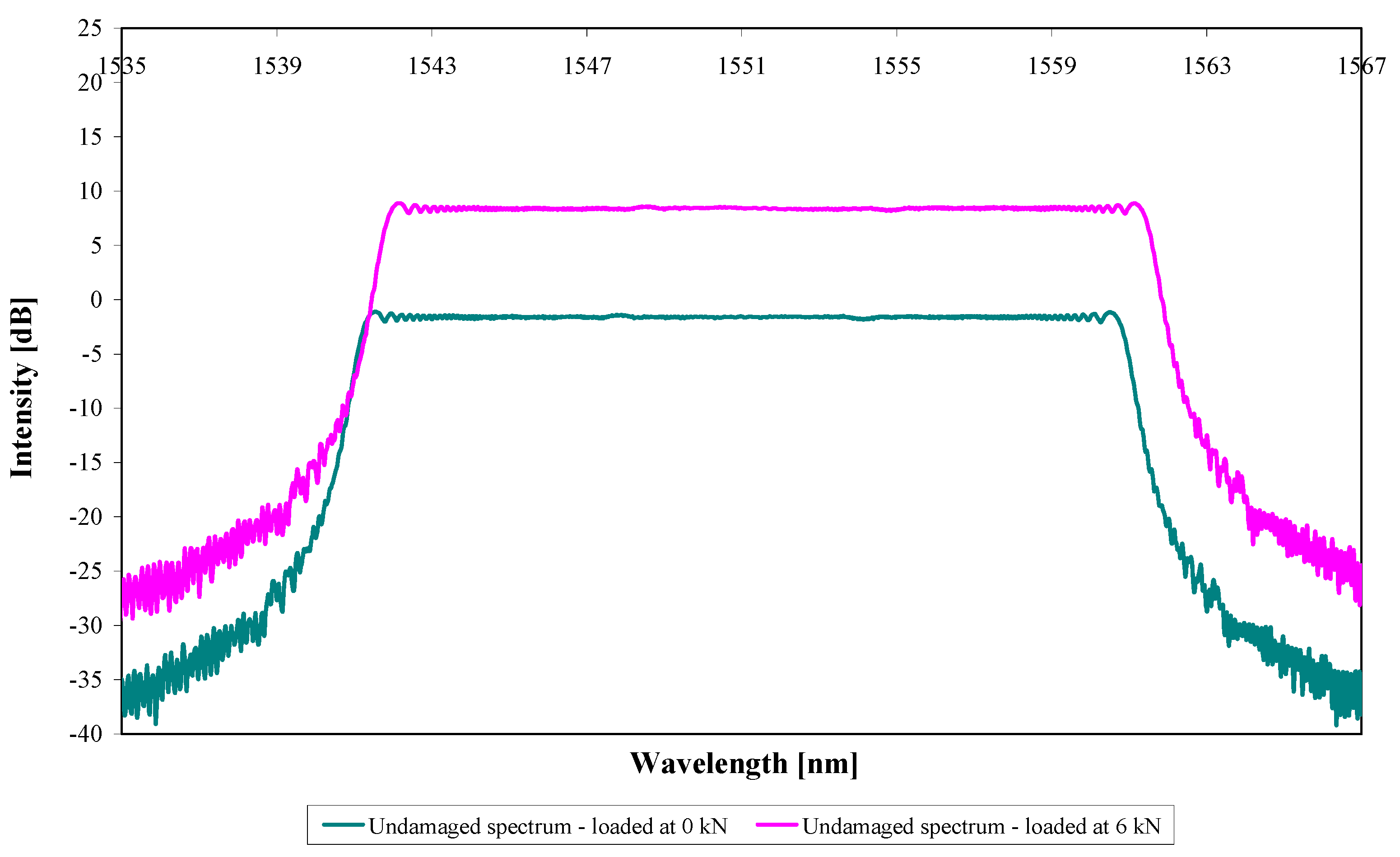
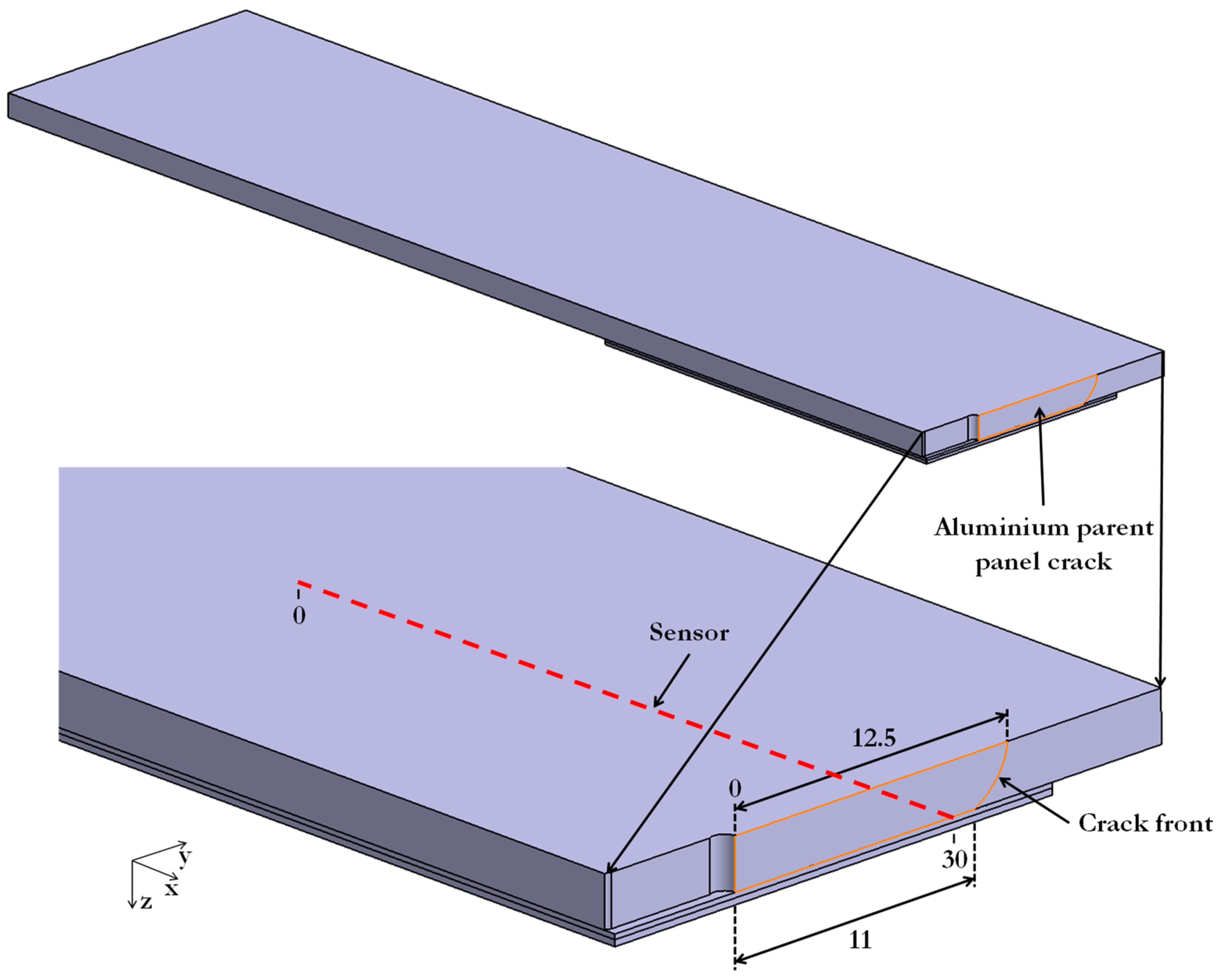
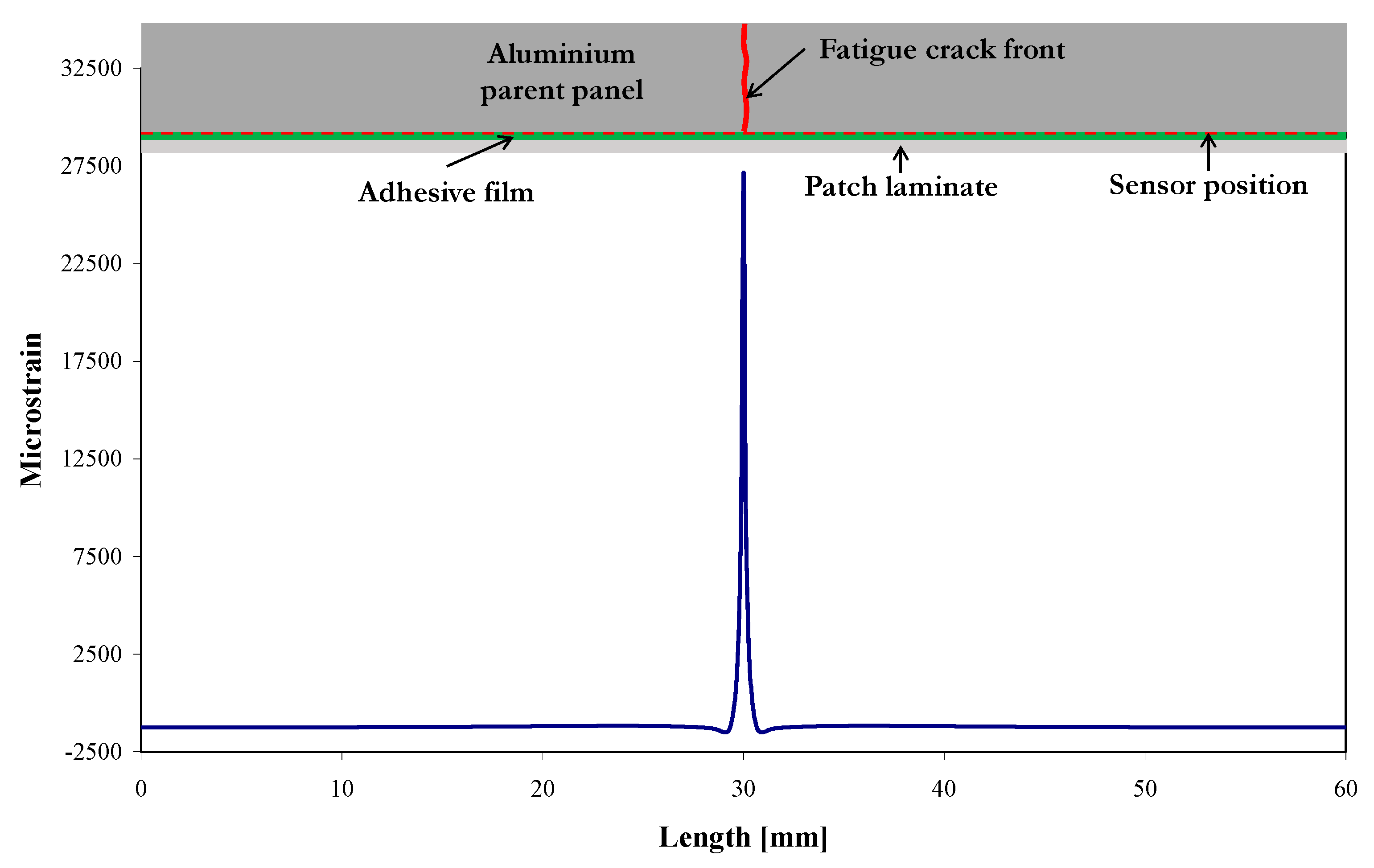


| E1 = 21,000 MPa | ν12 = 0.183 | G12 = 3700 MPa |
| E2 = 21,000 MPa | ν13 = 0.0305 | G13 = 3500 MPa |
| E3 = 8550 MPa | ν23 = 0.075 | G23 = 3500 MPa |
| EFM-73 OST = 2000 MPa | ν = 0.4 |
| EAl = 72,400 MPa | ν = 0.33 |
| Material | CTE [×10−6 °C−1] |
|---|---|
| Al-2014-T6 | 23 [21] |
| GFRP | 8 1 [22] |
| FM-73 OST | 50 [23] |
| Poisson’s ratio | 0.16 |
| Strain optic coefficients: | |
| P11 | 0.113 |
| P12 | 0.252 |
| Effective refractive index of CFBG sensor | 1.449 |
| Central wavelength (nm) | 1550 |
Publisher’s Note: MDPI stays neutral with regard to jurisdictional claims in published maps and institutional affiliations. |
© 2021 by the authors. Licensee MDPI, Basel, Switzerland. This article is an open access article distributed under the terms and conditions of the Creative Commons Attribution (CC BY) license (http://creativecommons.org/licenses/by/4.0/).
Share and Cite
Rito, R.L.; Ogin, S.L.; Crocombe, A.D. An Experimental and Numerical Study on the Use of Chirped FBG Sensors for Monitoring Fatigue Damage in Hybrid Composite Patch Repairs. Sensors 2021, 21, 1168. https://doi.org/10.3390/s21041168
Rito RL, Ogin SL, Crocombe AD. An Experimental and Numerical Study on the Use of Chirped FBG Sensors for Monitoring Fatigue Damage in Hybrid Composite Patch Repairs. Sensors. 2021; 21(4):1168. https://doi.org/10.3390/s21041168
Chicago/Turabian StyleRito, Rodolfo L., Stephen L. Ogin, and Andrew D. Crocombe. 2021. "An Experimental and Numerical Study on the Use of Chirped FBG Sensors for Monitoring Fatigue Damage in Hybrid Composite Patch Repairs" Sensors 21, no. 4: 1168. https://doi.org/10.3390/s21041168
APA StyleRito, R. L., Ogin, S. L., & Crocombe, A. D. (2021). An Experimental and Numerical Study on the Use of Chirped FBG Sensors for Monitoring Fatigue Damage in Hybrid Composite Patch Repairs. Sensors, 21(4), 1168. https://doi.org/10.3390/s21041168






